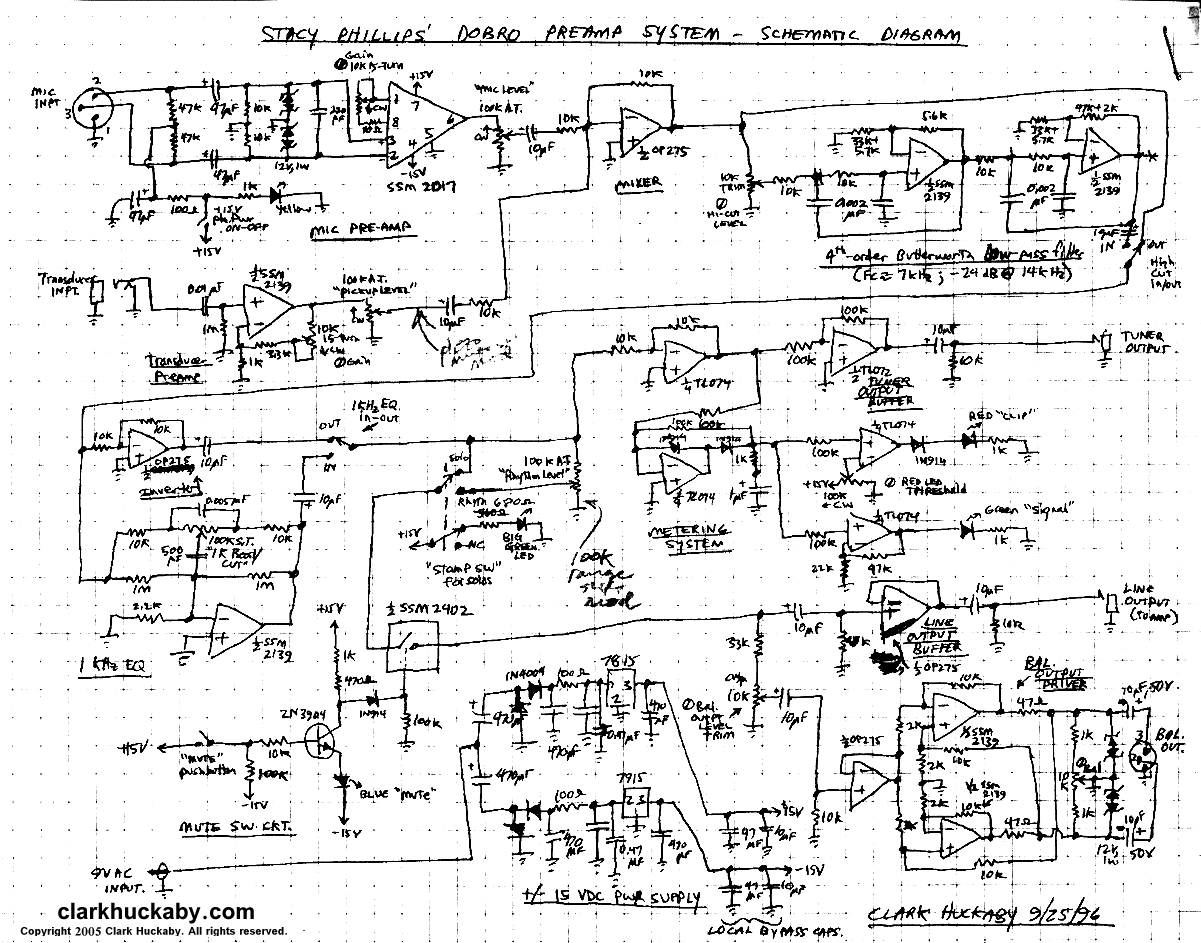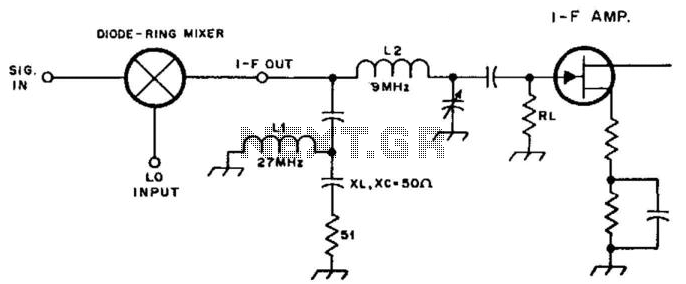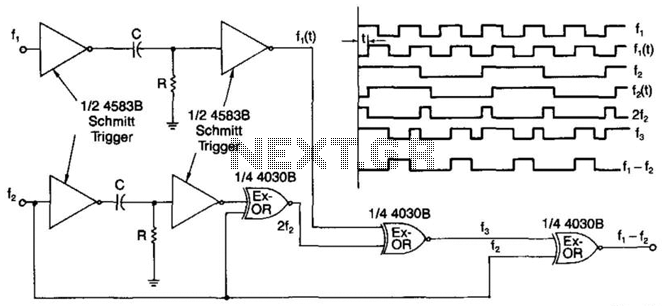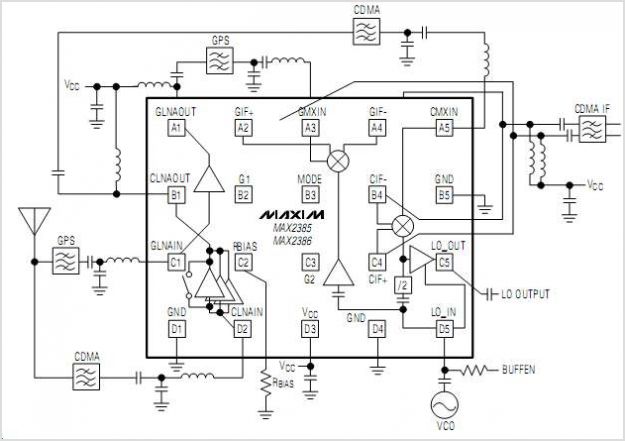
4-Channel Mixer
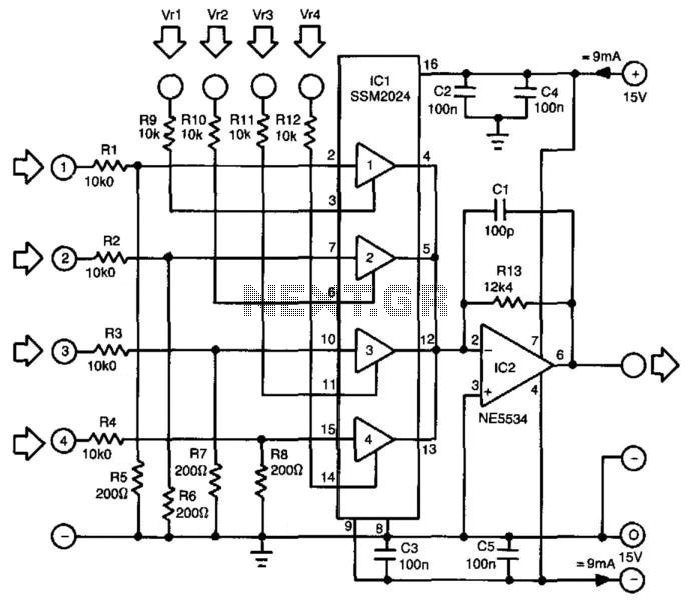
The proposed mixer is designed around four current-driven transconductance amplifiers contained in an SSM2024 from Precision Monolithics. To achieve low offset and high control rejection, the four inputs should have an impedance to earth of approximately 200 ohms. These impedances are provided by resistors R5 through R8, which also form part of a potential divider at each input. With the values indicated in the diagram, the nominal input signal is 1V (0 dBV). Distortion at this level is approximately 1%; at lower levels, it does not exceed 0.3%. The amplification of the current-driven amplifiers (CDAs) is determined by the current supplied to the control inputs. These inputs create a virtual earth, simplifying the calculation of the bias resistors required to convert the inputs into voltage-driven inputs. The output currents from the amplifier are summed by connecting the output pins. The current-to-voltage converter, IC2, translates the combined output currents into an output voltage. The value of R13 ensures that the amplification of IC2 remains at unity.
The mixer circuit utilizes the SSM2024, which is a quad transconductance amplifier that allows for high precision and low distortion in audio applications. The four transconductance amplifiers are configured to provide a differential input, enhancing the circuit's ability to reject common-mode signals and improve overall performance. The 200-ohm impedance to earth is crucial for maintaining signal integrity and minimizing noise, which is achieved through the careful selection of resistors R5 to R8. These resistors not only establish the necessary impedance but also work as part of a potential divider, ensuring that the input signal levels are appropriately managed.
The design stipulates that the nominal input signal is set to 1V, which is a standard level in audio systems. The distortion figures indicate that the mixer performs well within acceptable limits, with a maximum of 1% distortion at nominal levels and significantly lower distortion at reduced levels. This performance is essential for high-fidelity audio applications where clarity and accuracy are paramount.
The control inputs of the CDAs allow for dynamic adjustment of gain, with the amplification directly proportional to the current supplied. This design feature is advantageous because it allows for real-time control over the output characteristics of the mixer. The virtual earth configuration simplifies the design, as it allows for straightforward calculations for the bias resistors needed to convert the current-driven inputs into voltage-driven inputs.
The summation of output currents from the amplifiers through direct pin connections exemplifies a simple yet effective approach to combining signals. This method minimizes additional components and potential points of failure, promoting reliability in the circuit. The current-to-voltage converter IC2 plays a critical role in translating these summed currents into a usable output voltage, which can be interfaced with subsequent stages in an audio processing chain. The selection of resistor R13 to maintain unity gain for IC2 is a strategic decision that ensures the output voltage remains proportional to the input, preserving the integrity of the signal throughout the processing chain. The proposed mixer is designed around four current-driven transconductance amplifiers contained in an SSM2024 from Precisio n Monolithics. To obtain a low offset and high control rejection, the four inputs should have an impedance to earth of about 200 . These impedances are obtained from resistors R5 through R8, which also form part of a potential divider at each input.
With the values in the diagram, the nominal input signal is 1V (0 dBV). Distortion at that level is about 1%; at lower levels, it is not more than 0.3%. The amplification of the current-driven amplifiers (CDAs) is determined by the current fed into the control inputs. These inputs form a virtual earth so that calculating the values of the bias resistors (to transform the inputs into voltage-driven inputs) is fairly simple.
The output currents of the amplifier are summed by simply linking the output pins. The current-to-voltage converter, IC2, translates the combined output currents into an output voltage. The value of R13 ensures that the amplification of IC2 is unity.
The mixer circuit utilizes the SSM2024, which is a quad transconductance amplifier that allows for high precision and low distortion in audio applications. The four transconductance amplifiers are configured to provide a differential input, enhancing the circuit's ability to reject common-mode signals and improve overall performance. The 200-ohm impedance to earth is crucial for maintaining signal integrity and minimizing noise, which is achieved through the careful selection of resistors R5 to R8. These resistors not only establish the necessary impedance but also work as part of a potential divider, ensuring that the input signal levels are appropriately managed.
The design stipulates that the nominal input signal is set to 1V, which is a standard level in audio systems. The distortion figures indicate that the mixer performs well within acceptable limits, with a maximum of 1% distortion at nominal levels and significantly lower distortion at reduced levels. This performance is essential for high-fidelity audio applications where clarity and accuracy are paramount.
The control inputs of the CDAs allow for dynamic adjustment of gain, with the amplification directly proportional to the current supplied. This design feature is advantageous because it allows for real-time control over the output characteristics of the mixer. The virtual earth configuration simplifies the design, as it allows for straightforward calculations for the bias resistors needed to convert the current-driven inputs into voltage-driven inputs.
The summation of output currents from the amplifiers through direct pin connections exemplifies a simple yet effective approach to combining signals. This method minimizes additional components and potential points of failure, promoting reliability in the circuit. The current-to-voltage converter IC2 plays a critical role in translating these summed currents into a usable output voltage, which can be interfaced with subsequent stages in an audio processing chain. The selection of resistor R13 to maintain unity gain for IC2 is a strategic decision that ensures the output voltage remains proportional to the input, preserving the integrity of the signal throughout the processing chain. The proposed mixer is designed around four current-driven transconductance amplifiers contained in an SSM2024 from Precisio n Monolithics. To obtain a low offset and high control rejection, the four inputs should have an impedance to earth of about 200 . These impedances are obtained from resistors R5 through R8, which also form part of a potential divider at each input.
With the values in the diagram, the nominal input signal is 1V (0 dBV). Distortion at that level is about 1%; at lower levels, it is not more than 0.3%. The amplification of the current-driven amplifiers (CDAs) is determined by the current fed into the control inputs. These inputs form a virtual earth so that calculating the values of the bias resistors (to transform the inputs into voltage-driven inputs) is fairly simple.
The output currents of the amplifier are summed by simply linking the output pins. The current-to-voltage converter, IC2, translates the combined output currents into an output voltage. The value of R13 ensures that the amplification of IC2 is unity.


